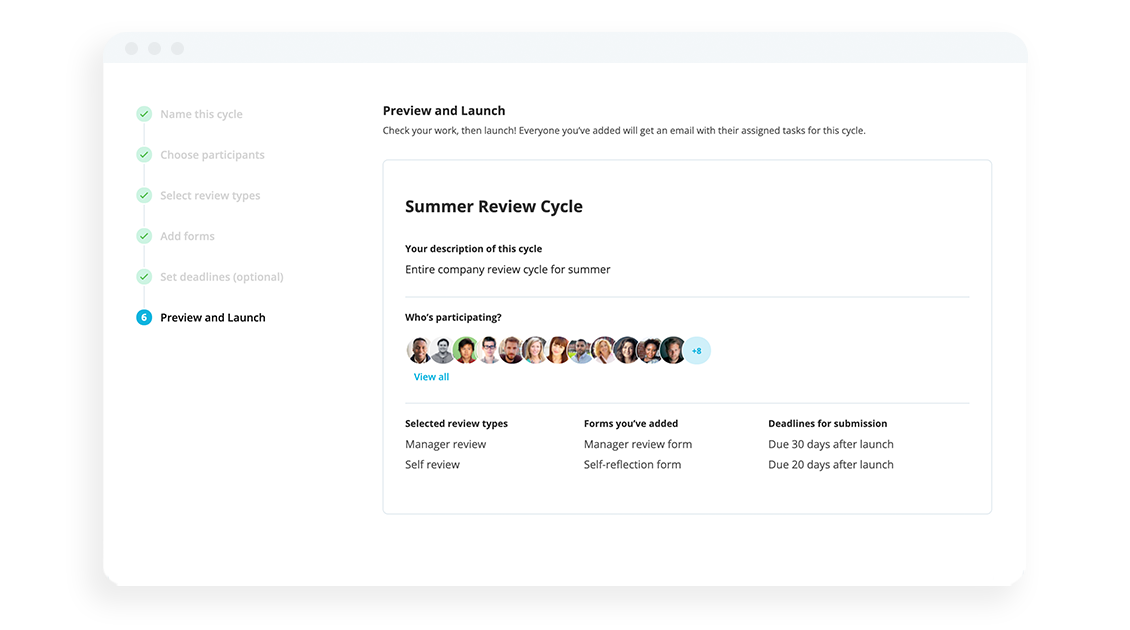Great Employee Goals: Setting & Creating Target Agreements

Are employee goals a priority for your organization? Should they be?If you have an underperforming employee, as an HR leader, you need to ensure that processes are in place to help them succeed.
After all, employees want to know exactly what goals they need to hit to succeed. Only then can they perform at their very best. In this article, we outline the thinking that goes into employee goals, the key elements, and why they matter for overall staff (and business) performance.
Set targets with your employees using our target agreement template today.What Are Employee Goals?
Employee goals consist of the tangible ways that employees want to improve, and the qualitative and quantitative metrics that prove them accomplished or not. For the most part, employee goals are determined, set, and reviewed by an employee and their direct supervisor/manager — but that's hardly the end of the story.
What are Types of Employee Goals?
Let’s break down employee goals a bit more. First, we should think of both short-term and long-term goals, which are goals that take place in a quarter or half (short-term), or a year or longer (long-term). Timelines for goals, especially goal completion, are important to set from the very beginning.
Then, let’s think about how we might organise goals. Typically, goals fall into three ‘buckets’:
Goal | Definition |
|---|---|
Process Goals | Goals attuned to improving the 'way' an employee works |
Performance Goals | Goals that look to meet a new standard (typically numbers-based). |
Outcome Goals | Goals that determine whether something was achieved or not (based around completion). |
Keeping these goals in mind, the next step is to make them a bit more concrete. This is typically the point where you may want to translate employee goals into what is known as a target agreement.
What is a Target Agreement?
Target agreements are a management tool based on the "management by objectives" principle established by Peter F. Drucker (1955). At least two parties, usually the employee and their manager, discuss the objectives the employees will be working toward over a defined period of time. At the end of that period, both reflect on whether the employee has achieved the objectives, and to what extent.
Earlier, we outlined three kinds of employee goals, but let’s talk about employee objectives (it’ll feel familiar, but slightly different):
Objective Type | Type |
|---|---|
Behaviour-Related Objectives | Responding to negative employer appraisals within a day. |
Task-Related Objectives | Reducing fluctuation rates by 5 percent. |
Developmental Objectives | Attending a seminar on how to optimize payroll processes. |
Jump Right In By Downloading Our Target Agreement Template

Get ahead of the game and help employees and managers work through goals and targets using our target agreement template. Click the button below to grab your own copy right now.
Try The TemplateWhat is the Purpose of a Target Agreement?
Target agreements are aimed at motivating employees and supporting them in planning out their careers. This process is overseen by HR, which implements a performance management process to ensure that all players within a company define goals systematically, always with an eye to developing employees and promoting employee loyalty.
Target Agreements: Advantages & Disadvantages
Target agreements are aimed at motivating employees and giving them guidance for their work (above all in terms of prioritizing). They also make it easier for managers to appraise an employee’s work. But, target agreements also come with their own set of disadvantages, too.
Advantages |
|---|
Tasks are prioritized: Employees know which goals have priority and are able to address these first. |
Employees are motivated: After all, their appraisals are based on facts rather than arbitrary preferences or emotions. |
Employees are given greater responsibility: They are able to define their personal path toward set goals. |
There is greater transparency and clarity: Both sides are aware of what is required. |
Goals foster commitment: This applies to both sides, as they have collaborated in establishing and setting employee goals. |
How Do You Set Employee Goals?
The first is to determine the nature of the goal itself, which often comes down to qualitative and quantitative. Simply put, it is easier to measure quantitative goals, but qualitative goals often come with more of a ‘story’ of progress.
That is why target agreements, as a function of employee goals and in coordination with managers and HR, should comprise a mixture of both. This way, goals and targets alike are set objectively (rather than arbitrarily).
Qualitative Goals | Quantitative Goals |
|---|---|
"Softer" goals. Common examples include improved customer satisfaction. Unfortunately, these "soft" goals are difficult to measure, and they should therefore always be expressed in the form of a concrete, specific goal, e.g. to improve the "satisfaction" rating in the next employee survey by one mark. | Measured by so-called KPIs (key performance indicators). These are usually expressed in the form of specific numbers, e.g. to improve the rating on an employer portal by one star. They are also derived from the department's goals and help ensure that corporate objectives are met. |
How Can HR Help Support Employee Goals?
Encouraging and measuring employee performance is one of the most important tasks managers, leads, and department heads perform. So, how can an HR or People Team help in the process?
Some of the most common ways include:
Implementing an HR software to help streamline processes.
Offering a secure and reliable place to document feedback.
Preparing a method for documenting and measuring employee goals.
Linking those goals to bonus payments or other rewards.
Automating performance cycles so reviews happen on time, all the time.
While these steps don’t need to happen sequentially, it helps to have all of them included in one place. In this sense, HR becomes a strategic enabler for managers to not only focus on employee goals but to help see them through.
Help Hit Targets By Setting Up Automated Performance Cycles

HR can support employees’ goals by establishing automated performance cycles that conform to your company’s unique culture, values, and processes. Come and see it in action by clicking the button below.
Automate Your Performance Cycles todayWhat are SMART Goals?
Taking a step back, HR and managers alike may see even greater returns if they focus not only on the nature of goals but on the tactical side of them, too. This is known as the SMART principle, which stands for:
Specific
Measurable
Achievable
Realistic
Timely
The SMART principle puts precise targets into a nutshell: Measurable goals ensure comparability, while realistic goals motivate employees and encourage them to perform at their best.
SMART Goal Examples: For Employees
It is essential that employee goals are actionable and, most of all, clear to employees. After all, they need to know what is expected of them and what they should do, which is why the SMART principle here is critical.
Let’s start with a bad goal example: “Attract younger consumer groups for a new instant organic soup”
SMART wording: “Increase awareness of a new brand of instant organic soup among men and women between the ages of 20 and 35 30% by the end of the calendar year.”
Other potential SMART goal examples here could include:
Generate X customer contacts within Y months
Increase the number of website visitors by X% within Y months
Increase the website conversion rate by X% within Y months
Generate X (positive) interactions on social media channel Y within Z months
Publish X articles in defined publications over the next Y months
Increase the market share by X% in the next business year
SMART Goal Examples: For HR
Poor wording: “Strengthen the employer brand”
SMART wording: “Improve ratings on kununu and Glassdoor by at least 1star within a quarter”
Other potential employee goals include:
Reduce employee turnover by X% within Y months
Generate X applications per advertised position in the next quarter
Reduce the time to hire per candidate from X to Y days over the next business year
Reduce sick days from X to Y days over the next business year
Shorten the time to the 1st interview per applicant from X to Y days in the next quarter
Reduce the cost per hire from X to Y € in the next quarter
Increase the offer acceptance rate by X% in the next quarter
Decrease resignations during the probation period by X% over the next business year
Download Our Target Agreement Template

Before we begin the next section, we’d highly recommend downloading our target agreements template. This way, you can make the main considerations while putting one together for a potential employee. Download it now.
Download The Template TodayBest Practices: Employee Goals & Target Agreements
Here are some helpful things to keep in mind when it comes to target agreements:
Best Practice | What To Know |
|---|---|
Keep It Real(istic) | Don't become overly ambitious in your objectives, both in terms of volume and the number of objectives themselves. We recommend that you define no more than three objectives per quarter. These should already include development goals. |
Defined Decision-Making | There is nothing more demotivating for employees than finding out that they need to discuss every single step with their supervisor. Define the rules right there and then during the performance review. |
No Milestone Left Unturned | How have things been going? How is the mood? Are there any problems? Where might goals need to be tweaked? |
Proper Documentation Is Key | Performance steps and target agreements should be documented to ensure that goals are transparent and can be revisited again later. This template will support you and your employees in doing this. |
Helping Employees Hit Their Goals
The first step in helping employees hit their goals is ensuring that managers and leaders have the tools they need to lead those conversations. That is where an HR software comes into play.
Using Personio, you can automate your performance cycles across your entire organization, schedule review meetings between leaders and employees, and even have a place to document feedback and set goals.
All of this offers an unbeatable foundation to put employee performance into focus. This helps foster a ‘goal-setting’ culture that is organised, attuned to employees, and clear for everyone to understand. Ultimately, your business benefits.

